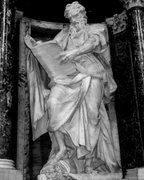On a totally unrelated note, my Renaissance history class yesterday also revealed some of the beauties of the Church dealing with marriage. It turns out that the dowries were actually the inheritance given to women by their fathers. Granted, this was then given to their husbands. But, in Italy and some other areas of Europe, at the heart of Christianity, if the husband died, then the woman got that dowry back. And people say the Church represses women?
Furthermore, men were accustomed to provide beautiful gifts to their new wives during the first two years of their marriage. Again, granted the Church repressed this. But, it wasn't because of trying to suppress women. It was trying to deal with the inflation of expensive living prices and in an effort to get men to marry earlier so that the marriage would be more unitive and fruitful. Plus, right after the black death, when the prices were getting expensive and men were marrying later, they were able to conceive, with their wives, less children. The population was falling short of its repopulation rate. And so in an effort to counter this, the Church wonderfully preached that people should live simpler lives to correct all of these problems. See, the Church does care about the future of society.
Even moreso, the Church's teachings on marriage, in contrast to the secular world view of the sacrament, were amazing. The secular view of marriage was a union that would advance the status of the male and female. In reaction to this, the Church preached that the purpose of marriage was to bind to people in a "great spiritual institution," and that it was a "blessed state in which men and women enter," as my professor said. It mirrored, and still does today, Christ's love for the Church.
The Church also sought to end the practice of endogamy, where a person would marry into his family, probably a fourth or fifth cousin. It taught that exogamy, marrying outside of the twelfth line of lineage would be better for society. This was partly due to the fact that people were marrying to keep wealth in the near family, and the Church realized that this was corrupting the holy sacrament of matrimony. So it tried to right the wrongs of the world and make marriage something truly special.
Finally, there was a question asked about prostitutes who had given up their jobs and converted their hearts. The student asked that if the woman had been deflowered, then how was a man supposed to marry her. And, the professor mentioned that the man who took in a reverted prositute was often, if not always, seen as charitable and actually esteemed for his good work and his imitation of Christ's forgiveness. In this day and age, Mary Magdalene was seen as a great example because she was that prostitute whom Christ forgave. And the Church promoted her veneration as a witness that conversion from the life of a prostitute was indeed possible.
How amazing is that?
Friday, September 16, 2005
Subscribe to:
Post Comments (Atom)

No comments:
Post a Comment